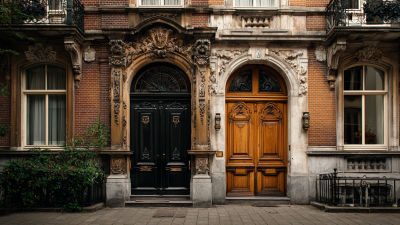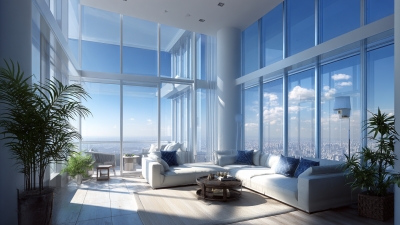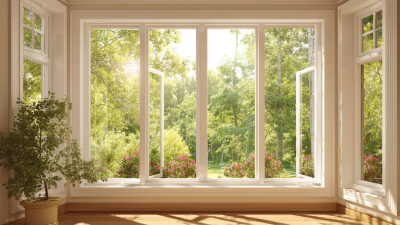Issues Faced When Choosing Residential Doors and Windows for Your Home
When it comes to enhancing the aesthetic appeal and functionality of your home, selecting the right residential doors and windows is pivotal. These elements not only contribute to the overall design but also play a crucial role in energy efficiency, security, and comfort. However, homeowners often face a myriad of challenges during the selection process, such as material choices, styles, and installation requirements. Understanding the various benefits of different types of residential doors and windows can help simplify these decisions. From traditional wooden frames to modern fiberglass options, each type comes with its unique advantages, thereby influencing the ambiance and energy performance of your living space. This blog aims to delve into the key issues encountered when choosing residential doors and windows, while highlighting the specific benefits that can guide homeowners towards making informed choices that align with their needs and preferences.

Table of Contents
[Hide]
Choosing the Right Material: Wood vs. Vinyl vs. Fiberglass for Doors and Windows
When it comes to choosing residential doors and windows, the material you select can significantly influence both aesthetics and functionality. Wood, vinyl, and fiberglass each offer unique benefits and challenges that can affect your decision-making process. Wood doors and windows provide an unmatched beauty and warmth, making them an ideal choice for traditional homes. However, they require regular maintenance to protect against warping, rot, and insect damage, which can be a deterrent for many homeowners.
On the other hand, vinyl is known for its affordability and low maintenance. Vinyl doors and windows are resistant to fading, scratching, and peeling, making them a practical choice, especially for those looking for durability without much upkeep. However, some may find the aesthetic appeal of vinyl less desirable compared to the classic feel of wood. Fiberglass is a strong contender as well, offering exceptional insulation properties and resilience against the elements, along with its ability to mimic the appearance of wood without the associated maintenance needs. Each material has its unique qualities, making it essential to weigh these factors against your home’s style and your lifestyle demands before making a decision.
Issues Faced When Choosing Residential Doors and Windows for Your Home - Choosing the Right Material: Wood vs. Vinyl vs. Fiberglass for Doors and Windows
| Material | Durability | Insulation | Maintenance | Cost |
|---|---|---|---|---|
| Wood | Good, but may warp or rot | Excellent | High; requires regular painting/staining | $$$ |
| Vinyl | Very Good; resistant to cracking | Good | Low; minimal upkeep required | $$ |
| Fiberglass | Excellent; withstands extreme temperatures | Very Good | Low; resistant to warping | $$$ |
Energy Efficiency Comparisons: Understanding Ratings and Their Impact on Cost
When selecting residential doors and windows, one of the most critical aspects to consider is energy efficiency. The ratings associated with these products provide essential insights into how well they can insulate your home and reduce energy consumption. Common rating systems, such as the Energy Star label, indicate products that meet strict energy efficiency guidelines set by the Environmental Protection Agency. Understanding these ratings can help you make informed decisions that not only enhance your home's comfort but also lead to long-term savings on utility bills.
Different materials and designs can dramatically affect the energy rating of doors and windows. For instance, double or triple-glazed windows have better insulation properties compared to single-pane options, reducing heat loss and improving overall energy efficiency. Additionally, the framing material—whether it's vinyl, wood, or fiberglass—plays a crucial role in thermal performance. While energy-efficient products may have a higher upfront cost, their ability to lower energy usage over time can result in significant savings, making them a wise investment for homeowners looking to improve their property's sustainability.
Energy Efficiency Comparisons: Residential Doors and Windows
The following chart illustrates the energy efficiency ratings of different types of residential doors and windows. This comparison helps homeowners make informed decisions while considering costs and efficiency.
Aesthetic Considerations: How Style Affects Your Home's Curb Appeal
When selecting residential doors and windows, aesthetic considerations play a crucial role in enhancing your home’s curb appeal. The style of these elements can significantly influence the overall look of your property, creating a first impression that reflects the character and personality of your home. Choosing the right design—whether it's modern, traditional, or somewhere in between—can harmonize with your home’s architecture, making it both inviting and visually pleasing.
Color schemes also play a vital part in the aesthetic impact of doors and windows. Bold, vibrant colors can make a home stand out, while muted, neutral tones often provide a classic elegance. The materials chosen, be it wood, fiberglass, or aluminum, contribute not only to durability but also to aesthetic appeal. Additionally, decorative features such as window grids, transoms, and unique door handles can enhance the style and create a cohesive look that elevates your home’s exterior. Ultimately, thoughtful selection in these areas can greatly improve your home's overall character and charm.
Security Features: Evaluating Options for Enhanced Safety in Your Home
When selecting residential doors and windows, security features are paramount for enhancing safety in your home. According to the National Institute of Standards and Technology (NIST), approximately 60% of burglaries occur through unsecured doors and windows, making it essential for homeowners to choose products that prioritize security. Reinforced doors, deadbolt locks, and impact-resistant glass can significantly deter potential intruders, providing peace of mind for families.

Moreover, many modern windows come equipped with advanced locking mechanisms that outperform traditional designs. A report from the Window and Door Manufacturers Association (WDMA) highlights that homes with multi-point locking systems experience a reduction in break-in attempts by as much as 50%. Choosing windows made from laminated or tempered glass can also enhance security, as these materials resist shattering better than standard glass, further protecting your home from unauthorized access. Investing in high-quality doors and windows not only bolsters your home's defense but also adds value and aesthetics to your property.
Cost Analysis: Long-term Investment vs. Initial Expenditure in Residential Doors and Windows
When considering residential doors and windows, homeowners often find themselves grappling with the balance between initial expenditure and long-term investment. The upfront costs of high-quality materials can be daunting; however, investing in durable doors and windows can yield significant savings over time. Energy-efficient options, for instance, may come with a higher price tag initially but can lead to lower utility bills and reduced maintenance costs, ensuring a better return on investment.

Additionally, the choice of doors and windows impacts the overall value of a home. Quality installations not only enhance aesthetic appeal but also improve security and energy performance. Homeowners should evaluate the longevity of materials and potential for technological upgrades, such as smart windows that regulate indoor temperatures automatically. In this way, understanding the long-term financial implications becomes essential in making informed choices, ultimately leading to a more worthwhile investment that benefits both the homeowner and the environment.
Related Posts
-

The Comprehensive Handbook for Choosing the Perfect Residential Doors
-

Exploring Alternative Designs for Doors and Windows: Innovative Options for Every Home
-

Innovative Designs for Doors and Windows That Transform Spaces Globally
-

Exploring Unique Alternatives to Traditional Big Windows for Modern Spaces
-

Mastering the Art of Selecting the Perfect Sliding Doors and Windows for Your Space
-

7 Secrets to Choosing the Best Energy Efficient Windows for Your Home